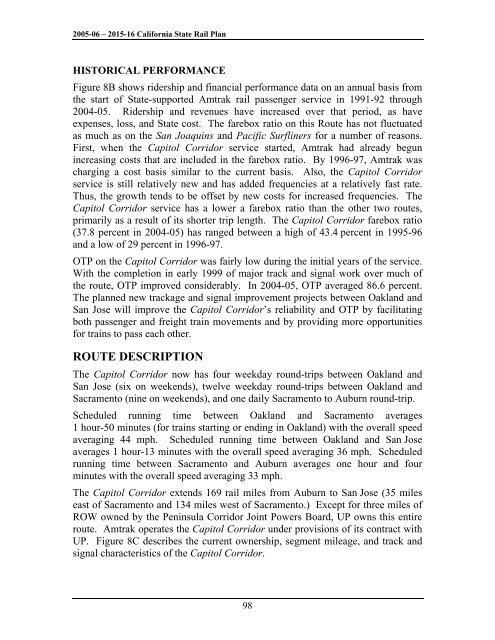California State Rail Plan 2005-06 to 2015-16
California State Rail Plan 2005-06 to 2015-16
California State Rail Plan 2005-06 to 2015-16
You also want an ePaper? Increase the reach of your titles
YUMPU automatically turns print PDFs into web optimized ePapers that Google loves.
<strong>2005</strong>-<strong>06</strong> – <strong>2015</strong>-<strong>16</strong> <strong>California</strong> <strong>State</strong> <strong>Rail</strong> <strong>Plan</strong><br />
HISTORICAL PERFORMANCE<br />
Figure 8B shows ridership and financial performance data on an annual basis from<br />
the start of <strong>State</strong>-supported Amtrak rail passenger service in 1991-92 through<br />
2004-05. Ridership and revenues have increased over that period, as have<br />
expenses, loss, and <strong>State</strong> cost. The farebox ratio on this Route has not fluctuated<br />
as much as on the San Joaquins and Pacific Surfliners for a number of reasons.<br />
First, when the Capi<strong>to</strong>l Corridor service started, Amtrak had already begun<br />
increasing costs that are included in the farebox ratio. By 1996-97, Amtrak was<br />
charging a cost basis similar <strong>to</strong> the current basis. Also, the Capi<strong>to</strong>l Corridor<br />
service is still relatively new and has added frequencies at a relatively fast rate.<br />
Thus, the growth tends <strong>to</strong> be offset by new costs for increased frequencies. The<br />
Capi<strong>to</strong>l Corridor service has a lower a farebox ratio than the other two routes,<br />
primarily as a result of its shorter trip length. The Capi<strong>to</strong>l Corridor farebox ratio<br />
(37.8 percent in 2004-05) has ranged between a high of 43.4 percent in 1995-96<br />
and a low of 29 percent in 1996-97.<br />
OTP on the Capi<strong>to</strong>l Corridor was fairly low during the initial years of the service.<br />
With the completion in early 1999 of major track and signal work over much of<br />
the route, OTP improved considerably. In 2004-05, OTP averaged 86.6 percent.<br />
The planned new trackage and signal improvement projects between Oakland and<br />
San Jose will improve the Capi<strong>to</strong>l Corridor’s reliability and OTP by facilitating<br />
both passenger and freight train movements and by providing more opportunities<br />
for trains <strong>to</strong> pass each other.<br />
ROUTE DESCRIPTION<br />
The Capi<strong>to</strong>l Corridor now has four weekday round-trips between Oakland and<br />
San Jose (six on weekends), twelve weekday round-trips between Oakland and<br />
Sacramen<strong>to</strong> (nine on weekends), and one daily Sacramen<strong>to</strong> <strong>to</strong> Auburn round-trip.<br />
Scheduled running time between Oakland and Sacramen<strong>to</strong> averages<br />
1 hour-50 minutes (for trains starting or ending in Oakland) with the overall speed<br />
averaging 44 mph. Scheduled running time between Oakland and San Jose<br />
averages 1 hour-13 minutes with the overall speed averaging 36 mph. Scheduled<br />
running time between Sacramen<strong>to</strong> and Auburn averages one hour and four<br />
minutes with the overall speed averaging 33 mph.<br />
The Capi<strong>to</strong>l Corridor extends <strong>16</strong>9 rail miles from Auburn <strong>to</strong> San Jose (35 miles<br />
east of Sacramen<strong>to</strong> and 134 miles west of Sacramen<strong>to</strong>.) Except for three miles of<br />
ROW owned by the Peninsula Corridor Joint Powers Board, UP owns this entire<br />
route. Amtrak operates the Capi<strong>to</strong>l Corridor under provisions of its contract with<br />
UP. Figure 8C describes the current ownership, segment mileage, and track and<br />
signal characteristics of the Capi<strong>to</strong>l Corridor.<br />
98













